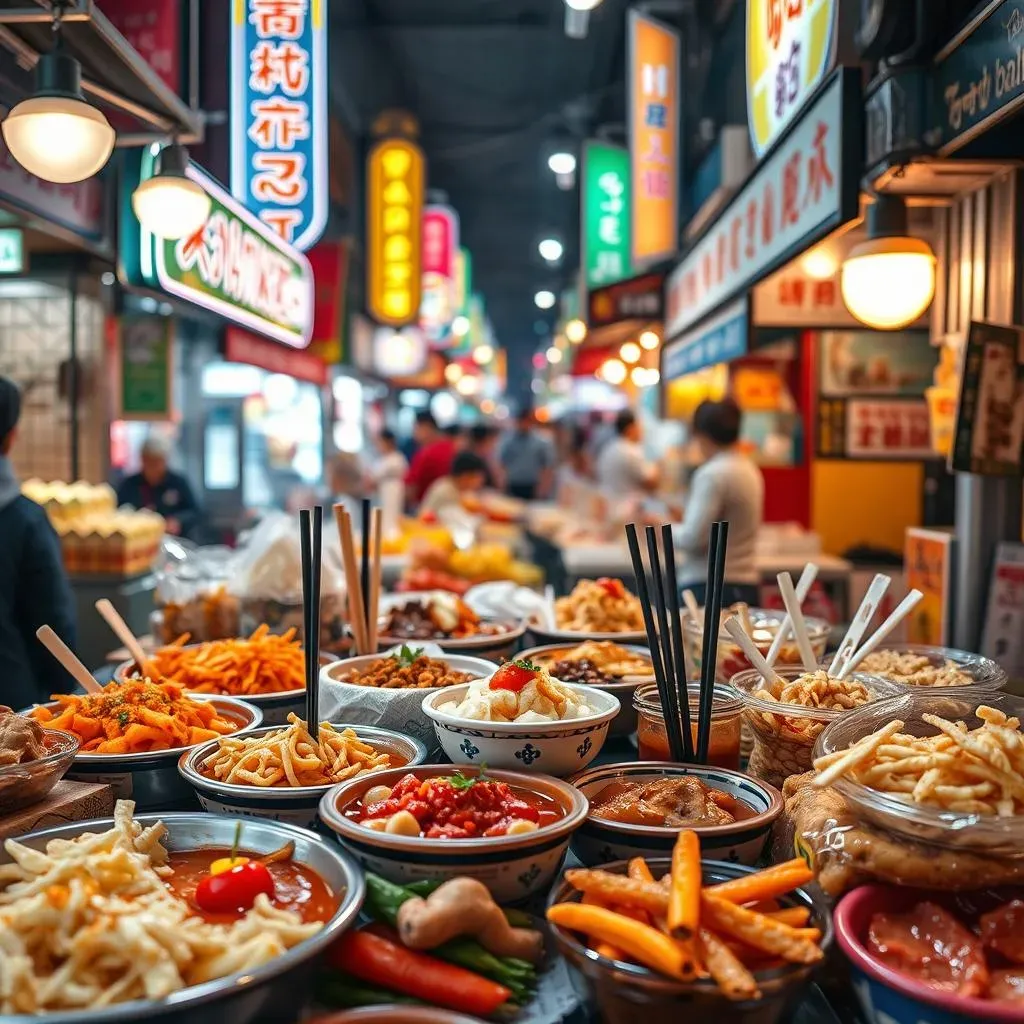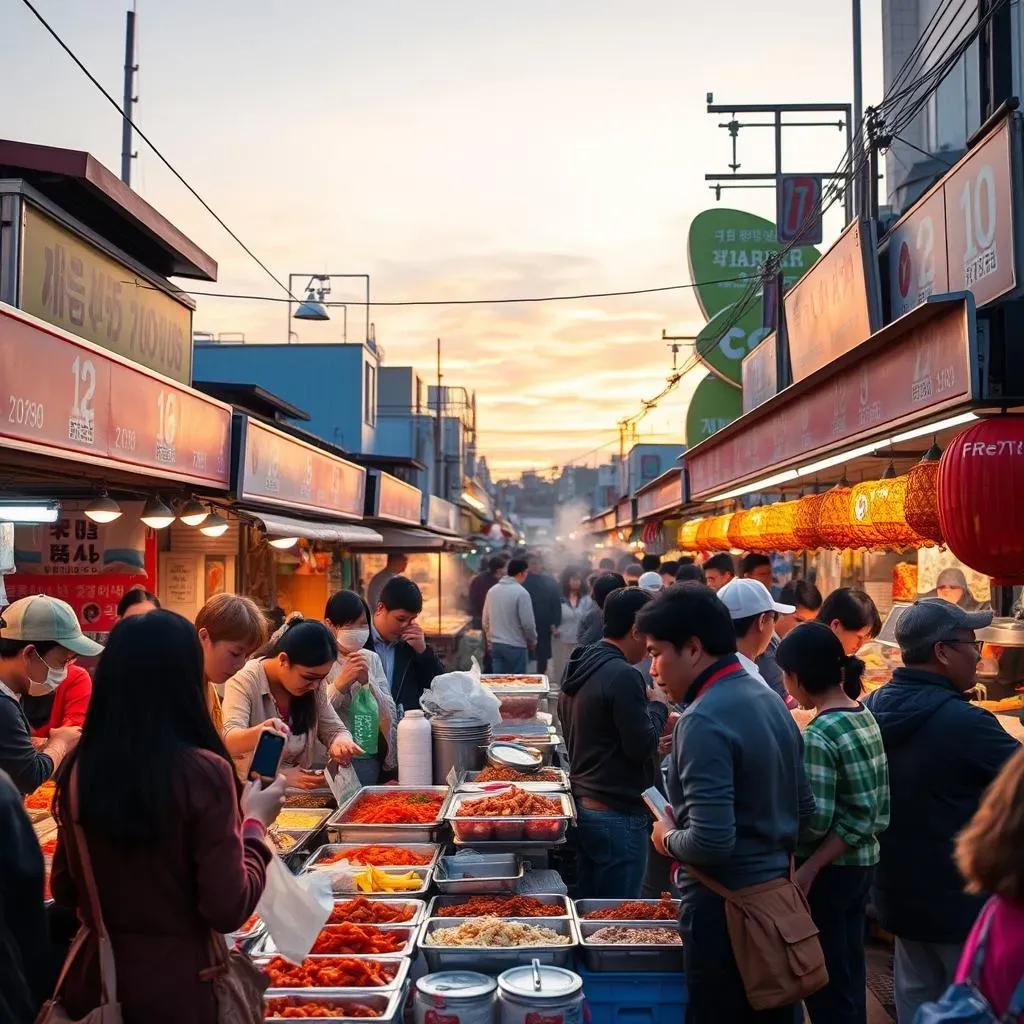Table of Contents
Get ready for a flavor explosion! This article is your passport to the exciting world of K-Street Korean food. We'll explore the irresistible allure of Korean street food, a culinary adventure that's taken the world by storm. From the sizzling, savory goodness of classic dishes to the trendy twists on traditional favorites, we'll uncover the unique tastes and textures that make K-Street Korean food so captivating. Prepare your taste buds for a journey through some of the most popular dishes, discovering where to find these culinary gems, whether you're in a bustling city or searching for the best Korean street food near you. We'll also touch upon the rich culture and traditions that underpin this vibrant cuisine, giving you a deeper appreciation for the heart and soul of Korean food. So, buckle up and let's embark on this delicious exploration of K-Street Korean food – a culinary adventure you won't want to miss!
The Allure of Korean Street Food
The Allure of Korean Street Food
A Sensory Symphony
Imagine this: You're strolling through a bustling Korean market, the air thick with the aroma of sizzling meats, sweet rice cakes, and savory seafood. Brightly colored food stalls beckon, each offering a unique culinary experience. The sounds are just as captivating – the sizzle of the grill, the chatter of vendors, and the happy murmurs of customers enjoying their treats. It's a sensory overload in the best possible way, a feast for all your senses. This vibrant atmosphere is a huge part of the allure of Korean street food; it’s not just about the taste, it’s about the whole experience.
One of the things that makes Korean street food so special is its incredible diversity. You can find everything from classic dishes like tteokbokki (spicy rice cakes) and eomuk (fish cakes) to more modern creations like Korean corn dogs and tornado potatoes. Want to try something different? Check out this cheese-based Korean street food! The possibilities are endless, ensuring there's something to satisfy every palate. And the best part? It's all incredibly affordable, making it a perfect option for budget-conscious foodies.
Dish | Description |
|---|---|
Tteokbokki | Spicy rice cakes in a gochujang sauce |
Eomuk | Fish cakes, often served on a stick |
Hotteok | Sweet pancakes filled with brown sugar and cinnamon |
Beyond the Familiar
Korean street food isn't just about familiar flavors; it's about unexpected combinations and exciting new tastes. Many dishes incorporate unique ingredients and cooking methods that you won't find anywhere else. For example, the way they prepare kimbap (seaweed rice rolls) is an art form in itself; it’s not just about the ingredients, but the precise rolling technique. And don’t forget the various sauces and toppings, which can range from sweet and spicy to savory and umami-rich, adding another layer of complexity and deliciousness. This constant innovation keeps the culinary scene fresh and exciting.
What's truly remarkable about Korean street food is its ability to blend tradition with modernity. While many classic dishes have been passed down through generations, vendors are constantly experimenting with new flavors and ingredients, creating exciting fusion dishes that appeal to both locals and tourists. Looking for some recipe ideas? You might want to check out this Korean street food recipe book! This dynamic evolution ensures that Korean street food remains a vibrant and ever-changing culinary landscape.
- Fusion dishes combine traditional Korean flavors with international influences.
- Vendors often experiment with unique ingredients and cooking methods.
- The constant innovation keeps the culinary scene fresh and exciting.
A Cultural Experience
But the allure of Korean street food goes beyond just the food itself. It’s deeply intertwined with Korean culture and traditions. Sharing food is a cornerstone of Korean social life, and street food plays a vital role in fostering a sense of community and connection. The bustling atmosphere of the markets, the friendly interactions between vendors and customers, and the shared experience of enjoying delicious food together all contribute to a rich and memorable cultural experience. Think of it as a delicious window into the soul of Korea.
Moreover, Korean street food often reflects the country's history and culinary heritage. Many dishes have been passed down through generations, carrying with them stories and traditions that have been preserved and celebrated. By indulging in these culinary delights, you're not just satisfying your hunger; you’re connecting with a rich cultural tapestry that has been woven over centuries. Consider this a culinary time travel experience! If you're looking for some easy recipes to try at home, take a look at this selection of easy Korean street food recipes.
Popular KStreet Dishes: A Flavorful Journey
Popular KStreet Dishes: A Flavorful Journey
Spicy Sensations: Tteokbokki and Beyond
Let's start with a Korean street food classic: tteokbokki! These chewy rice cakes are bathed in a fiery-red sauce made with gochujang (Korean chili paste), gochugaru (Korean chili flakes), and a medley of other flavorful ingredients. The heat level can vary, from a gentle warmth to a face-melting inferno, so choose your adventure wisely! Beyond the classic, you'll find countless variations—some add seafood, others toss in cheese, and some even incorporate ramen noodles for extra texture. It's a dish that's both comforting and exciting, a perfect example of Korean street food's ability to balance familiar flavors with unexpected twists. Want to try making your own? Check out this easy recipe collection!
Another popular spicy option is sundae, a type of blood sausage. Now, before you wrinkle your nose, hear me out! Korean sundae isn't your typical blood sausage. It's often filled with vermicelli noodles, vegetables, and sometimes even glass noodles, giving it a surprisingly light and refreshing texture. The taste is savory and subtly spicy, with a unique, almost earthy flavor. It's typically served with a dipping sauce that adds another layer of flavor complexity. If you're feeling adventurous, sundae is a must-try. For more adventurous eaters, there's always the option of Halal Korean street food!
- Tteokbokki: Chewy rice cakes in spicy sauce.
- Sundae: Savory blood sausage with various fillings.
- Kimbap: Seaweed rice rolls with various fillings.
Sweet Treats and Savory Snacks: A Balanced Feast
Korean street food isn't all about spice; there's a whole world of sweet and savory snacks waiting to be discovered. Hotteok, for instance, are warm, fluffy pancakes filled with a sweet brown sugar and cinnamon mixture. The contrast between the crispy exterior and the gooey, warm filling is simply divine. Imagine biting into one on a chilly evening; it's pure comfort food! And if you're looking for something savory, you can't go wrong with eomuk, or Korean fish cakes. These are often served on a stick, making them perfect for on-the-go snacking. They have a slightly chewy texture and a savory flavor that's both satisfying and addictive. For a more substantial meal, consider a K-bob!
Another popular street food is twigim, a type of Korean fritter. These can be made with various ingredients, from vegetables to seafood to even kimchi. They're usually deep-fried until golden brown and crispy, making them a delightful textural experience. The flavors vary depending on the ingredients, but they're all incredibly satisfying. And for those with a sweet tooth, there's Bungeoppang, a fish-shaped pastry filled with sweet red bean paste. It’s a cute and delicious treat that’s perfect for a quick snack. You can find many variations of Korean street food pancakes as well!
Dish | Description | Sweet or Savory? |
|---|---|---|
Hotteok | Sweet pancake with brown sugar and cinnamon filling | Sweet |
Eomuk | Fish cakes, often served on a stick | Savory |
Twigim | Korean fritters with various fillings | Savory |
Bungeoppang | Fish-shaped pastry filled with red bean paste | Sweet |
Finding KStreet Delights: Locations and Recommendations
Finding KStreet Delights: Locations and Recommendations
Tracking Down Tasty Treats
So, you're ready to embark on your own K-Street food adventure? Awesome! But where do you even begin? Finding the best spots can feel like searching for a hidden gem, but fear not! The beauty of K-Street food is its widespread appeal; you're likely to find delicious options in many major cities with sizable Korean populations. Think New York City, Los Angeles, or even smaller hubs like Charlotte, NC. A quick online search for "Korean street food near me" will usually uncover a wealth of options. Don't be afraid to explore different neighborhoods; you might discover hidden culinary gems tucked away in unexpected places. For a more targeted search, consider specifying your location—for example, "Korean street food in Orlando" or "Korean street food NYC"—to refine your search results.
Online reviews can be your best friend! Sites like Yelp, Google Maps, and TripAdvisor are treasure troves of user feedback, offering valuable insights into the quality of food, service, and overall atmosphere of different establishments. Pay attention to photos; a picture is often worth a thousand words, especially when it comes to mouthwatering Korean street food! Reading reviews can also help you identify the most popular dishes and get a sense of what to expect at each location. But don't be afraid to venture beyond the top-rated spots; sometimes, the smaller, lesser-known places offer the most unique and authentic experiences. And remember to always check the opening hours before heading out. You can also check out this guide to the best Korean street food near you!
- Use online search engines and review sites.
- Explore different neighborhoods and cities.
- Read online reviews to gauge food quality and atmosphere.
- Don't be afraid to try lesser-known places.
Beyond the Big Cities: A Culinary Adventure
While major cities boast a wealth of Korean street food options, don't discount smaller towns and cities! You might be surprised at what you find. Many smaller communities have thriving Korean populations and a hidden culinary scene waiting to be explored. Local farmers' markets and community events are often great places to discover hidden gems. Keep an eye out for food trucks and pop-up stalls; these often offer unique and exciting culinary experiences. Talking to locals is another great way to uncover secret spots and hidden culinary treasures. They often know the best places to find authentic and delicious Korean street food, even if those places aren't widely advertised.
Remember, the hunt itself can be part of the fun! Embrace the unexpected, try new things, and be open to culinary adventures. Don't be afraid to step outside your comfort zone. You might discover a new favorite dish, a hidden gem of a restaurant, or even a whole new appreciation for the diversity and richness of Korean street food culture. For example, you might find a great place serving dynamite Korean street food and sushi in your town. Don't be afraid to ask locals for recommendations; they are often the best source of information about hidden culinary gems. And remember, the best culinary discoveries are often the ones you stumble upon unexpectedly!
Location Type | Pros | Cons |
|---|---|---|
Major Cities | Wide variety of options, easy to find | Can be crowded and expensive |
Smaller Towns | More unique and authentic experiences, often less crowded | Fewer options, may require more searching |
Beyond the Street: Korean Food Culture and Traditions
Beyond the Street: Korean Food Culture and Traditions
Sharing is Caring (and Delicious!)
Korean culture places a huge emphasis on sharing food. It's not just about sustenance; it's about connection, community, and strengthening relationships. Street food perfectly embodies this spirit. Imagine a group of friends huddled around a table, sharing plates of tteokbokki and eomuk, laughter and conversation flowing as freely as the soju. That communal aspect is a big part of the appeal—it’s a social experience as much as a culinary one. It’s about building bonds over shared deliciousness.
This emphasis on sharing extends beyond just friends and family. The bustling atmosphere of Korean street food markets is a testament to the communal nature of the food itself. Vendors and customers interact freely, creating a vibrant and lively atmosphere. It's a place where people from all walks of life come together, united by their love of good food. This sense of community and shared experience is something truly special and adds another layer of richness to the overall enjoyment of Korean street food. For a deeper dive into home-style Korean cooking, check out this guide to Korean home cooking and street food.
- Sharing food is a central aspect of Korean culture.
- Street food markets foster a sense of community and connection.
- Interactions between vendors and customers are often friendly and lively.
A Culinary History: From Tradition to Trend
Many K-Street dishes have deep roots in Korean history and tradition. Think of kimchi—that spicy, fermented cabbage that's a staple of Korean cuisine. It's not just a side dish; it's a testament to Korean resourcefulness and ingenuity, born from a need to preserve food during harsh winters. Similarly, many other street food staples have evolved over centuries, adapting to changing tastes and ingredients while retaining their essence. This historical context adds another layer of depth and appreciation to the culinary experience. The food isn’t just something to eat; it’s a story waiting to be tasted.
But Korean street food isn't stuck in the past! It's constantly evolving, incorporating modern influences and innovative techniques. You'll find fusion dishes that blend traditional Korean flavors with international influences, resulting in exciting and unexpected culinary creations. This blend of tradition and modernity is a testament to the dynamism of Korean culture and its ability to embrace change while honoring its heritage. Looking for a unique twist on classic dishes? Check out these Korean street food options in NYC!
Dish | Historical Significance | Modern Variations |
|---|---|---|
Kimchi | Traditional method of preserving cabbage | Kimchi jjigae (stew), kimchi fried rice |
Bibimbap | Mixed rice with vegetables and meat | Variations with different proteins and sauces |
Bulgogi | Marinated grilled beef | Bulgogi tacos, bulgogi burgers |